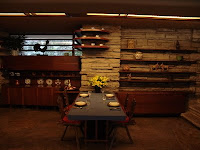Seen & Unseen | Natural & Unnatural

Went to Falling Water today with my Norwegian sister and her son. Winston was not allowed in because he is five years old. So, he and his grandmother hiked around and did .... something.
What struck me the most was how manipulative and controlling Frank Lloyd Wright was. The whole house seemed to shriek, You must live my way. My vision is what is important! Our wet dish rag of a tour guide seemed overwhelmed by his genius. I think it flavoured my perceptions.
I enjoyed the evidence of subtle battles between Mrs. Kaufmann and Wright. The blinds she put in the guest room. The gorgeous freeform 14th century peasant chairs she had imported from Europe to use at their dining room table. The chair designed by Wright
 was on display in the guest house. I think Mrs. Kaufmann was correct in her choice. Her chairs represented a female element. Lovely naturally curvilinear wood perched on three legs - how pagan and earthy. Very unlike the controlled stiff straight lines that Wright imposed on nature. Wright wanted all the views unobscured. Mrs. Kaufmann wanted privacy in her bathroom. I loved the way she used potted plants as a natural curtain. The guest house also reflects her influence. It is more spontaneous and natural than the main house. The type of art hung, the cushions on the built in couches reflected a sense of colour and texture that Wright's designs don't use. Interestingly enough, the pool which Mrs. kaufmann loved and used frequently is easily accessible from the guest house. (I get the feeling she spent a good amount of time up there - even if nobody said so.)
was on display in the guest house. I think Mrs. Kaufmann was correct in her choice. Her chairs represented a female element. Lovely naturally curvilinear wood perched on three legs - how pagan and earthy. Very unlike the controlled stiff straight lines that Wright imposed on nature. Wright wanted all the views unobscured. Mrs. Kaufmann wanted privacy in her bathroom. I loved the way she used potted plants as a natural curtain. The guest house also reflects her influence. It is more spontaneous and natural than the main house. The type of art hung, the cushions on the built in couches reflected a sense of colour and texture that Wright's designs don't use. Interestingly enough, the pool which Mrs. kaufmann loved and used frequently is easily accessible from the guest house. (I get the feeling she spent a good amount of time up there - even if nobody said so.)By the end of the tour, I was also unimpressed by the sameness of every room. The way in which each bedroom and bath had only one method for occupancy. Edgar J. Kaufmann, their son, had a same knack for design rebelliousness as his mother. He made several untenable modifcations to his suite that would have thrown Wright into seething tantrums.

You can tell a lot about a family and the vision of the architect by what is seen and unseen. The kitchen was deemed unimportant” because only the servants used it And the servants quarters were now the administrative offices. In the words of the tour guide, they look just like every other room in the house, except instead of those little white buttons they had to call the servants, they have bells. The highest wall on the property was placed to screen the carports and servants quarters - effectively rendering them invisible. They don’t want us to remember the human price of grandeur and elegance.
It is truly stunning and innovative architecture. Here are some pictures and the wikipedia page. But, I’m glad I don’t live that way.
Comments